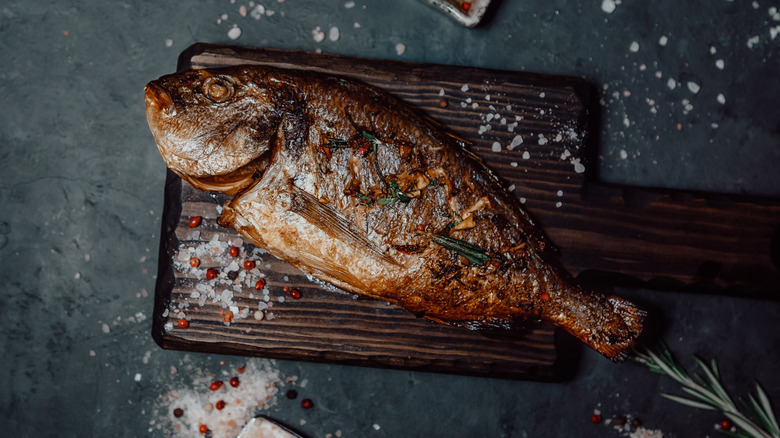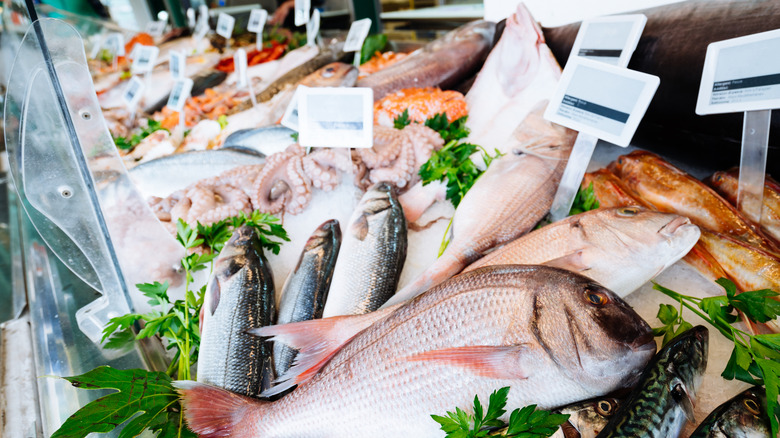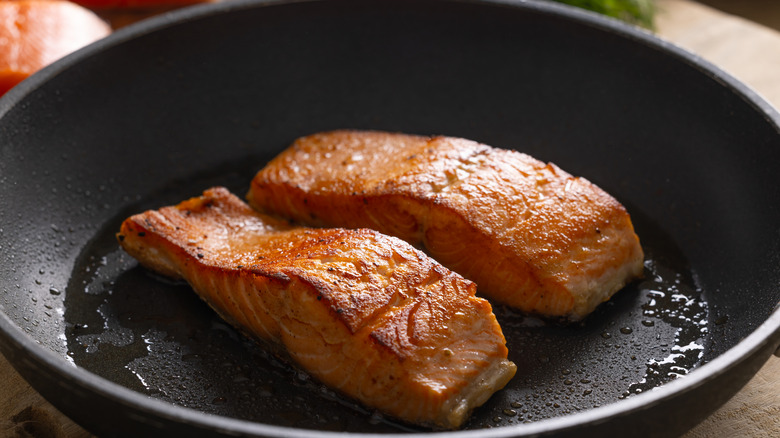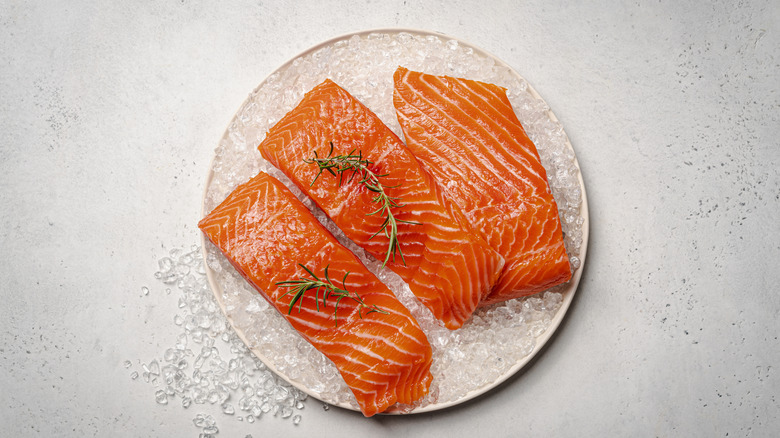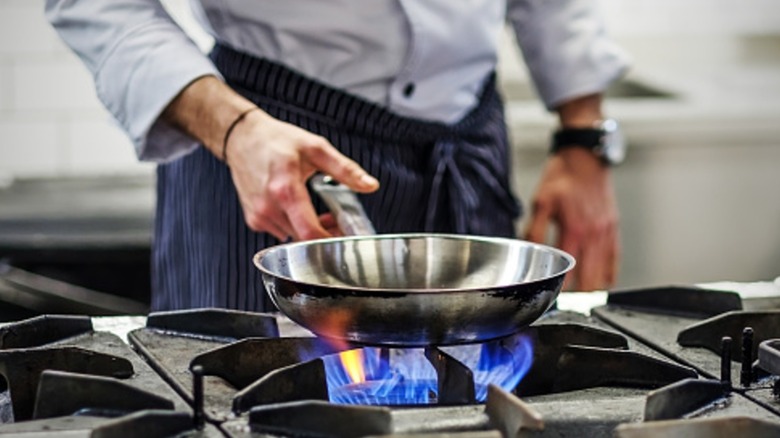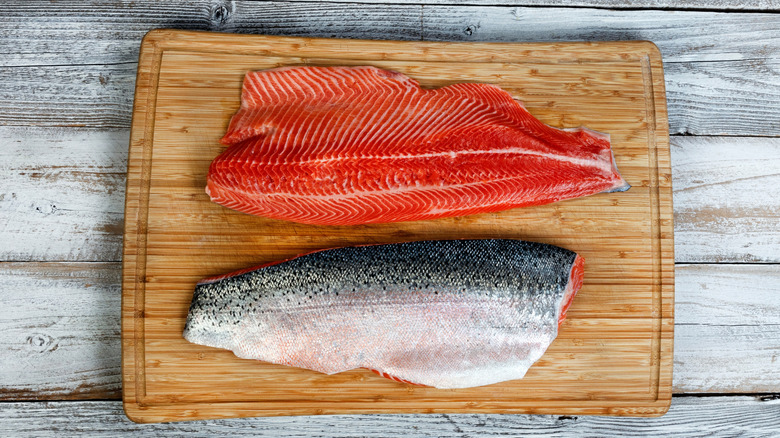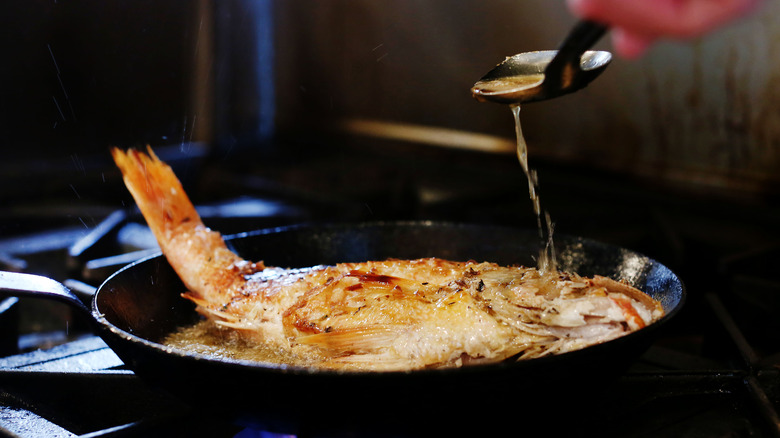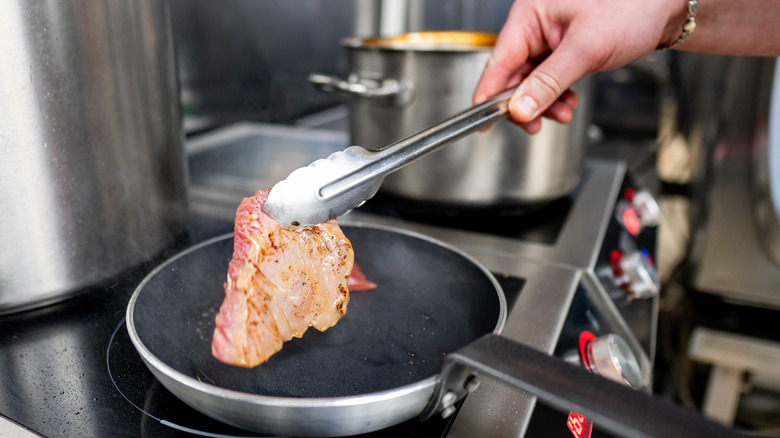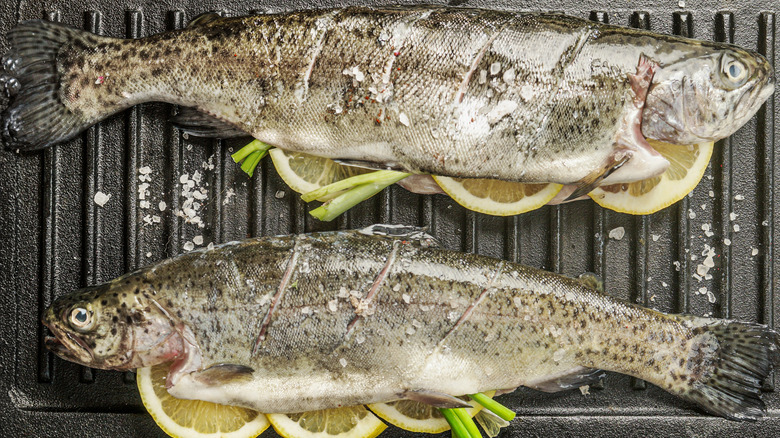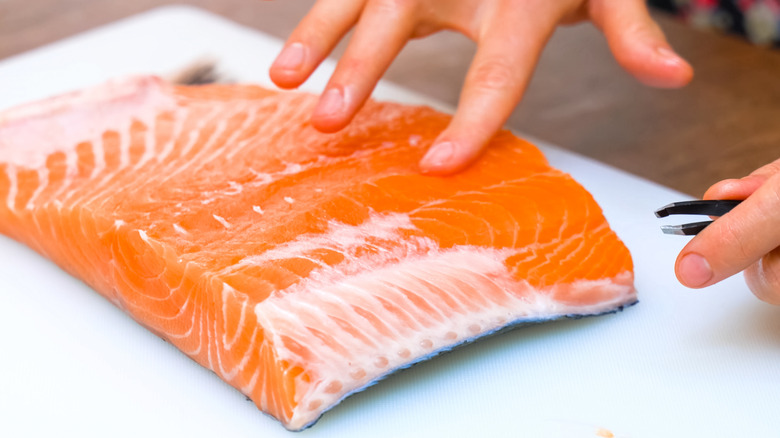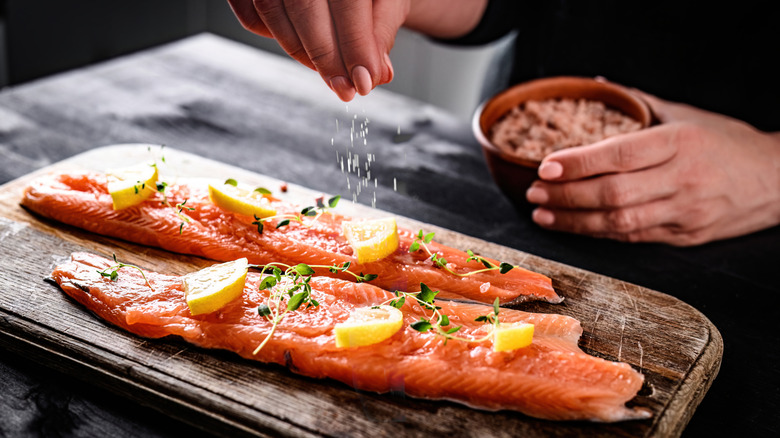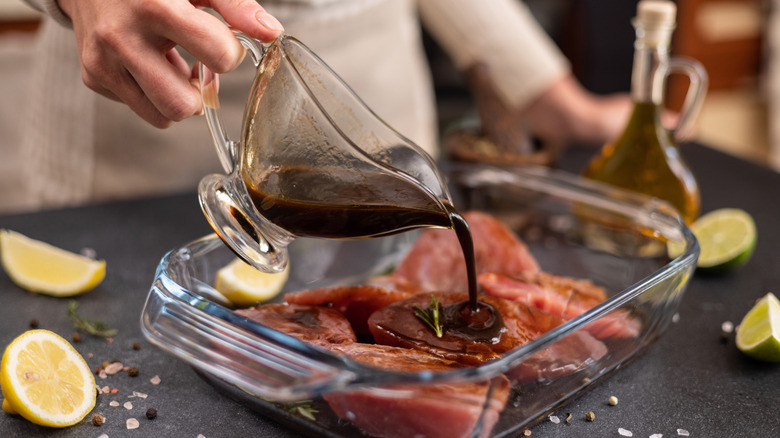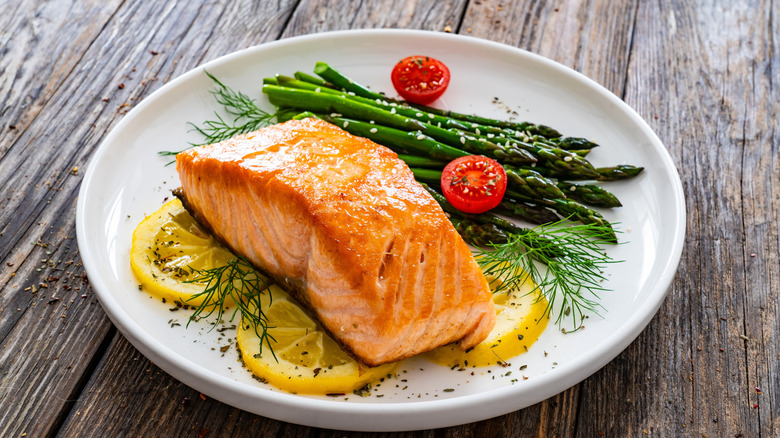Common Mistakes To Avoid When Cooking Fish
The average American eats up to 20 pounds of seafood every year, and fish makes up a large portion of this figure. Lighter than red meat and rich in omega-3s, fish has become a popular choice for health-conscious diners seeking lean protein. From grilling salmon with the skin on to whipping up easy fish tacos, fish dishes can be quick to prepare and delicious — provided that you know what you are doing in the kitchen.
The bad news is that fish can be surprisingly unforgiving, with even seemingly small mistakes turning top-quality filets into a kitchen flop. Skipping simple prep steps, overmarinating, and leaving the fish on high heat for too long can all ruin the final dish. Luckily, with a little know-how, many of these mistakes can be easily avoided, allowing you to cook fish that's tender, flavorful, and perfectly done. To take the guesswork out of it, we have consulted several chefs and culinary experts to find out where home cooks usually go wrong. Our experts include Maricel Gentile, owner of Maricel's Kitchen and Chef Ambassador for the South Korean Ministry of Fisheries; Tim Richardson, executive chef at Hank's Seafood Restaurant; Andre Blasczak, executive chef at The Westin Grand Cayman Seven Mile Beach Resort & Spa; and Leonardo Diaz, executive chef at Allison Restaurant & Bar at Hilton Cabana Miami Beach Resort. Our fish authorities also share their tips for avoiding these all-too-common culinary slip-ups.
Opting for low-quality fish
All good meals start with fresh, top-quality ingredients. No amount of culinary skills can compensate for subpar, low-grade seafood. This is why selecting fresh fish that has been properly handled and stored is essential for both taste and food safety. Maricel Gentile is adamant that lackluster fish can ruin a dish: "Low quality fish will taste dull, the texture turns mushy, and the flesh will not hold firm. Good fish should be bright in flavor, firm to the touch, and cook up beautifully in your dish." She adds that high-quality flash-frozen fish is preferable to so-called fresh fish that has been poorly handled.
So what are the key signs of quality when purchasing fish? According to Tim Richardson, certain tell-tale signs can help you distinguish premium seafood from lower-grade options. "When buying whole fish, look for clear eyes, bright red or pink gills, and a vibrant red bloodline — these are all signs of freshness," he says. "If possible, buy local for the best quality and to support sustainable sourcing."
Using the wrong cooking method for the fish type
There are more than 200 different types of edible fish. With such a variety, it's not surprising that various fish are best suited to different cooking methods. For instance, delicate fish such as sole or flounder are likely to fall apart if prepared in the same way as more robust fish like tuna. As such, understanding the characteristics of each fish type helps ensure that the chosen cooking technique enhances, rather than ruins, its natural qualities.
Andre Blasczak says that proper fish preparation begins with knowing your product and working with its natural qualities rather than against them. "Factors like fat content, thickness, and delicacy play a big role in how they should be prepared," he says. "For instance, firm fish such as mahi-mahi or swordfish hold up beautifully on the grill, while more delicate varieties like snapper or cod are better suited to gentler approaches like steaming or poaching." He also notes that using the wrong method can negatively impact flavor and texture, resulting in fish that's dry or falls apart.
Not patting fish dry before cooking
Just as you wouldn't sear a wet steak, you shouldn't cook fish that's still damp, as this can interfere with the cooking process. Maricel Gentile is quick to point out this simple yet crucial detail that can ruin your meal, saying, "Moisture is the enemy of a good sear. If you do not pat the fish dry, it will steam instead of browning. Always blot with paper towels so the surface is dry before it touches the pan or grill. This one small step gives you that golden, crisp finish."
While patting raw fish dry might seem minor, it can mean the difference between restaurant-quality results and a soggy dinner. This is because moisture can interfere with the Maillard reaction, which is responsible for creating that appealing golden-brown crust on the surface of the fish. Not only does this chemical culinary process make the exterior of the fish crisp, but it also contributes to its flavor, making it richer and more complex. Fish that's properly dried is also more likely to absorb seasonings, marinades, or butter during the searing process.
Failing to preheat the pan or grill and using the wrong type of oil
Whether you are preparing fish in a pan or on a grill, preheating the cooking surface is a non-negotiable, as explained by Leonardo Diaz. "A hot surface is critical to prevent sticking and to develop proper sear marks," he says. "Sear marks are a classic indicator of a professional chef, even if you don't have professional training."
Andre Blasczak agrees that starting the fish in a cold pan almost guarantees that it will stick, tearing the delicate flesh and destroying the golden, crisp finish. "Always give the pan or grill time to heat properly; you should hear an immediate sizzle when the fish makes contact," he elaborates. "That initial burst of heat helps lock in flavor, texture, and appearance."
To ensure that you get that clean sear and crisp skin without imparting bitter, burnt flavors, the smoke point of your cooking oil matters. Maricel Gentile recommends canola, grapeseed, or avocado oil. "These let the fish shine without burning or adding an overpowering taste. Olive oil is wonderful too, but use it on medium heat so it does not smoke," she adds. "The key is to avoid butter or low smoke point oils as the base, because they burn too quickly, though you can finish with butter at the end for richness."
Cooking fish skin-side up
Fish come in many forms — some are sold whole and gutted, others as neatly trimmed filets. While fish filets often come without the skin for convenience, opting for skin-on cuts can help greatly during the cooking process, provided you know how to make the most of it. Maricel Gentile says that it's crucial to start cooking fish skin-side down, adding, "The skin protects the flesh and crisps beautifully. Fish is delicate and needs gentle handling." Tim Richardson agrees, saying the presentation side of the fish should always hit the pan first.
Indeed, cooking fish filets skin-side up is asking for culinary trouble. Given that the skin acts as a protective barrier that holds the flesh together as it cooks, fish cooked skin-side up may fall apart or stick to the pan's surface. On the other hand, preparing the fish skin-side down will leave you with a beautifully crispy and flavorful skin. In terms of presentation, it's also likely to make the fish more appetizing, giving the dish a more professional look.
Using overly high or low heat
Just as different fish require slightly different preparation methods, the temperature you cook them at can make or break the final dish. Tim Richardson highlights the danger of improper temperature control, saying, "If the heat is too high, the fish can burn on the outside before cooking through; too low, and it won't develop that beautiful golden crust."
Whether you are preparing fish in a pan or on a grill, it's important to get the surface to medium-high to high heat before placing the filet down. "Once the oil begins to smoke, carefully add your seasoned fish," Richardson details. "Watch closely as the fish begins to caramelize — this is the key to building flavor and texture." He adds that the heat should be reduced to medium once the fish develops a sear and also recommends transferring the pan to a preheated oven to roast it, as long as the fish is robust enough to handle it. "After a few minutes, remove the pan, gently flip the fish, and return it to the oven for another 2–3 minutes, or until it reaches your desired doneness."
Overcooking fish
Overcooking is one of the most common mistakes home cooks make when preparing fish. Even an extra minute or two in the pan or on the grill can turn the fish from beautifully flaky to overly hard and rubbery. Perhaps Andre Blasczak summarizes this best, saying, "Because fish cooks much faster than many other proteins, it can quickly go from tender and moist to dry and tough once the proteins begin to break down."
So, how can we test that the fish is done before it's overcooked? As a rule of thumb, the fish's interior should lose its raw, glossy sheen and separate into neat flakes when gently pressed. For a more accurate gauge of doneness, use a meat thermometer — the fish is ready when it registers 145 degrees Fahrenheit at its thickest point. That said, Leonardo Diaz advises pulling the fish off the heat a little earlier. "Fish continues to cook with residual heat, so it should be removed from the heat source just before it's done," he explains. "Also, a brief rest allows juices to settle, ensuring tenderness and preventing dryness when served."
Flipping fish too often
Flipping fish too often is a recipe for disaster. This is because turning the fish multiple times during the cooking process is likely to cause it to break apart, particularly if you are cooking delicate filets like tilapia or sole. Maricel Gentile warns against overhandling the fish, advising, "Let the fish cook on one side until it naturally releases from the pan or grill, then turn it once. Turning it over and over breaks it apart." Andre Blasczak echoes this sentiment, adding that flipping the fish too many times during the cooking process is likely to disrupt the formation of a flavorful crust. "The best approach is to let the fish cook undisturbed on one side until a golden sear develops, then flip it just once to finish cooking gently, keeping the inside moist and delicate."
As with most cooking rules, there are exceptions to the one-flip method. This is highlighted by Tim Richardson, who notes that some fish require a more hands-on approach. "The only exception is when you're searing a fish like tuna, where the goal is to quickly sear all four sides while keeping the center rare," he says. "In that case, multiple turns are intentional and part of the technique."
Not using citrus to stop fish from sticking to the grill
When it comes to grilling fish, small cooking tricks can make a huge difference. Professionals know that high-quality meals often come down to the little details — the heat level of the grill, the state of the grates, and how you prep its surface. While these adjustments may seem subtle, they can prevent the fish from sticking, tearing, or cooking unevenly.
One particularly clever trick involves using citrus to stop fish from sticking to the grill. Leonardo Diaz is a big fan of this method, explaining, "Citrus helps release the fish from the pan naturally and also adds brightness to the flavor. It's a simple and effective trick to create a well-rounded seafood dish." To get the most out of this technique, start by layering orange or lemon slices directly on the grill grates before placing your fish on top. Not only will this make the fish easy to remove, but it will ensure that it takes on some of the flavor of the fruit, elevating it with a zesty undertone.
Forgetting to remove pin bones from fish filets before cooking
Pin bones are not actually bones in the real sense of the word. Instead, they are long, thin, calcified nerve endings embedded in the filets of fish such as salmon and trout. Unfortunately, being needle-like, they can be difficult to spot. However, if pin bones are not removed before cooking, they may not just ruin a meal but also scratch the inside of your mouth or even get stuck in your throat.
Considering the potential discomfort pin bones can cause, it's not surprising that chefs take the time to remove them. Tim Richardson is one of these meticulous professionals, highlighting that skipping this step is an all-too-common mistake. "Smaller fish tend to have fine pin bones that are more difficult to spot, so using a pair of fish tweezers will make the job much easier," he says. Richardson also recommends running your fingers over the fish once you've removed the bones as a fail-safe final step.
Overseasoning and seasoning at the wrong time
A heavy hand with seasoning can quickly overpower the delicate flavor of fish. After all, it's the delicate flavor that is precisely what makes fish so appealing and versatile in the first place. You want the seasoning to enhance, not compete with the mild flavor of the fish. A sprinkle of salt, a touch of spice, or a drizzle of citrus can go a long way toward bringing out the subtle sweetness of fish without overwhelming its natural character, as long as you don't go overboard.
Seasoning fish too early can also significantly affect its overall texture, as highlighted by Tim Richardson. "It's important to lightly season both sides of the fish just before searing or grilling to ensure every bite is well-balanced and flavorful," he says. "Seasoning too early can draw moisture out of the fish, which can affect both texture and browning, so it's best to season right before it hits the heat."
Marinating fish for too long
Just like with beef or chicken, marinating fish can enhance its overall taste. And it's easy to see why a mixture of oil, herbs, spices, and acids like lemon juice or vinegar can infuse seafood with vibrant flavor. Beyond boosting its brightness, a marinade can also help tenderize fish and lock in its moisture as it cooks.
Given that fish is more porous than, say, beef, keeping it in a marinade for too long can easily backfire, as pointed out by Leonardo Diaz. "Acidic marinades can 'cook' the fish before it hits the pan, through a process called protein denaturation, which leaves the fish's texture mushy. I recommend short marination times that are sufficient to enhance flavor without compromising texture," he says. For best results, try not to leave it soaking in a marinade for longer than 10 to 15 minutes — that is, unless you are using fish for a traditional ceviche, where the acid is intentionally used to 'cook' the fish.
Not letting fish rest after cooking
Overcooked fish can be a real letdown — what should be a flaky and flavorful meal can quickly turn dry and chewy. This is why many professionals recommend removing fish from the stove or grill just before it reaches full doneness to allow the residual heat to finish the cooking process. Letting fish rest before serving also makes it more moist because juices move toward the surface of the protein during cooking, and if you cut immediately into the filet, those juices will spill out, leaving the fish drier and less flavorful.
Maricel Gentile points out that even a brief resting period can elevate the final result. "Pulling fish off the heat and serving immediately may seem right, but giving it one or two minutes to rest makes it juicier. The carryover heat finishes the cooking, and the juices settle back into the flesh," she says. Gentile also mentions that this rest period is the perfect moment to add butter, delicate herbs, or final seasonings to give your dish a rich and flavorful finish. "The Japanese use this moment to add a brush of soy or miso glaze. I like to put a squeeze of calamansi (or any citrus) on the fish."
